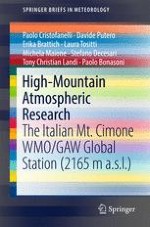This book presents the results of 20 years of atmospheric composition research studies carried out at the high-mountain (2,165 m a.s.l.) Observatory "O. Vittori" in Italy, part of the only global station in the Mediterranean region that belongs to the World Meteorological Organization’s Global Atmosphere Watch (WMO/GAW). It provides a comprehensive study with updated results for the most important atmospheric climate-altering and pollutant compounds based on the continuous observations at Mt. Cimone. Further, the book addresses the following main research topics in atmospheric sciences: non-CO2 greenhouse gases, reactive gases, aerosol particles and natural radioactivity.
The book also presents an overview of the measurement site (both in terms of its geographical location and technical facilities), as well as extensive climatology references (in the form of plots and tables) for the atmospheric compounds monitored there. As such, it offers a must-read for atmospheric scientists, stakeholders, undergraduate and graduate students in related fields.
